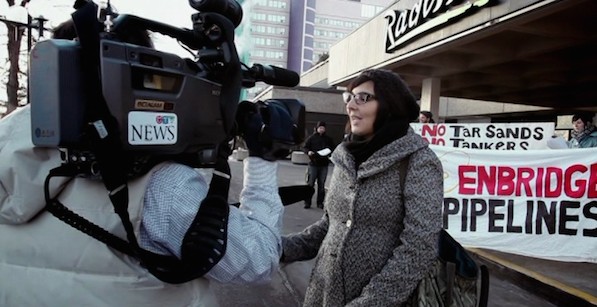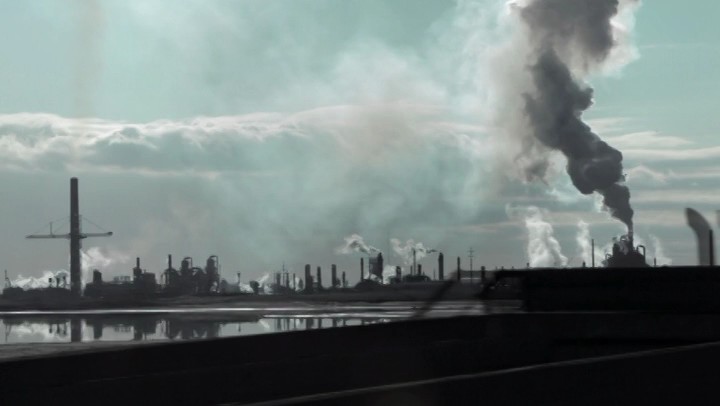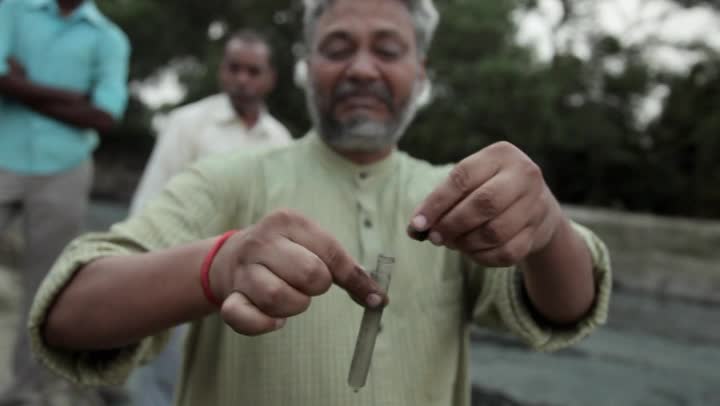[Editor’s note: Fandor is highlighting films making a social impact this month.]
“I’m not an environmentalist,” Eriel Deranger explains in Gayatari Roshan and Emmanuel Vaughan-Lee’s Elemental. “I’m an indigenous rights activist.” Deranger—a thoughtful, fearless, tattooed young mother (with another baby on the way)—is the most charismatic among the doc’s globe-spanning subjects, although all are remarkable: a trio of boundary-pushers who share the belief that humankind’s survival rather urgently requires forging a more symbiotic relationship with the natural world.
Deranger, raised by a politically engaged mother amid Canada’s First Nations community, is a Rainforest Action Network campaigner who knows first-hand the destruction wrought by Northern Alberta’s Tar Sands development—“the largest man-made industrial project on earth,” and a blight that prioritizes oil production over the health of the people and formerly pristine land that surround it. (You’ve heard of the controversial Keystone XL Pipeline Project? This would have been its source.) We also meet Ganges River Basin Authority Commissioner Rajendra Singh, who launches a “war of purification” on behalf of India’s most important and sacred waterway, and Australian entrepreneur Jay Harman, an industrial designer whose fascination with (and deep respect for) nature shapes all of his inventions, including a device he believes can help mitigate global warming.
Roshan and Vaughan-Lee bring nature into every frame, lingering on scenes both horrific—children splashing in Ganges waters we’ve just seen declared toxic; belching smokestacks looming over Canadian wilderness—and inspiringly beautiful. But though the environment is the key issue for each activist profiled in Elemental, the film is more about the human roadblocks that crop up, inevitably, when anyone tries to do something good for the planet.
For Singh, it’s not just an Indian government that turns a blind eye toward industrial pollution (“Corporate interests trump community needs,” he points out, with the air of someone who’s said it before and will say it again), it’s also the regular folk who live along the Ganges and bathe in its waters. Though they’d like to see the river cleansed, why should they trust yet another outsider who bustles in and gives speeches filled with hollow promises? “We’ll talk later. Let’s go clean the Ganges!” Singh replies, but he knows it’s not that simple (on many levels; we see him dry-heaving after spending time surrounded by filthy muck).
Meanwhile, Deranger has the opposite problem. She’s a part of the community she’s trying to protect; her New York City-based employer, RAN, is not, and there are disagreements over organizational style and resource allocations. Their inevitable clash—all while grassroots protests against the pipeline are reaching critical importance—is hinted at early in Elemental, when Deranger dons battle armor in the form of a cocktail dress and heads to a gala to “hobnob with donors.” In one of the film’s most memorable scenes, she manages to keep her composure during an encounter with a tipsy-seeming Robert F. Kennedy, Jr., who is handsy, name drop-y, patronizing and altogether unsavory in just a minute or two of screen time.
You can’t blame Deranger for believing that interrupting a meeting of pipeline executives, or painting a protest banner to hang outside the bank that supports Tar Sands, seems like a much better use of her time. Unsurprisingly, she and RAN part ways as the film progresses—and she keeps up the fight on her own terms.

Harman’s battle is even more pragmatic. In order for his inventions to have an environmental impact, he needs deep-pocketed investors willing to take a chance on his unconventional ideas—which, to be honest, make perfect sense once he explains his philosophy. He’s a born problem-solver and he approaches each new dilemma (even something as daunting as climate change) with a simple question that he hopes will inspire the solution: “How does nature do it?”
Of course, big-money types aren’t often into taking chances; witness one fellow who crisply remarks that Harman’s ideas are “breakthrough stuff … but some traditional engineers think you’re full of it.” It’s a cold rejection, made all the more devastating by the fact that Harman is earnestly, genuinely trying to make the world a better place.
Along the way, we learn more about Elemental’s subjects through their family relationships, particularly Deranger’s bond with her moody tween daughter (at one point ducking out of a protest march to field a frantic phone call about a bad hair day). Though Deranger, Singh and Harman clearly embody what it means to be an “eco-warrior,” they are also dynamic personalities in their own right; we see all of them become frustrated and exhausted, but persevere to find the hope they need to return to battle. As the old saying goes, the personal is political, and the keenly observed Elemental—further elevated by its elegant production values—brings that into focus, illuminating three diverse lives, all fully committed to diverse but intrinsically linked causes.







